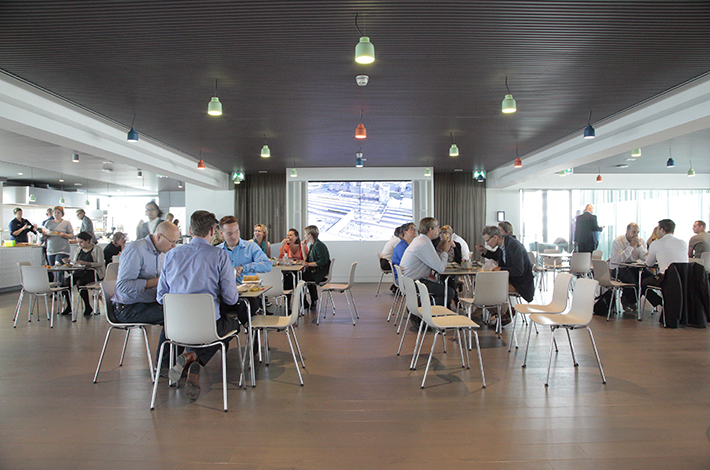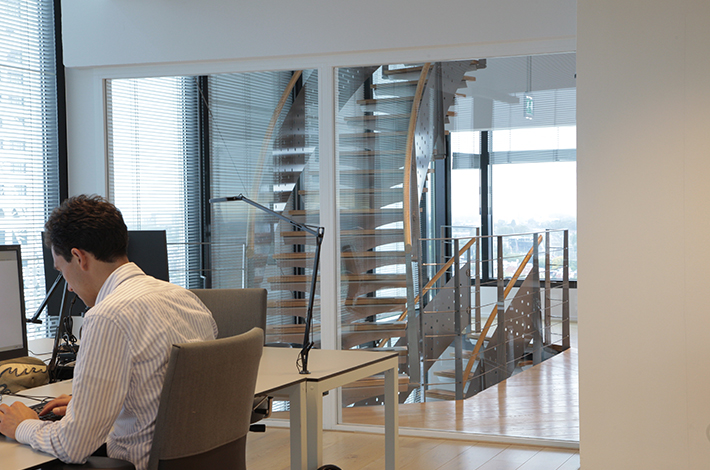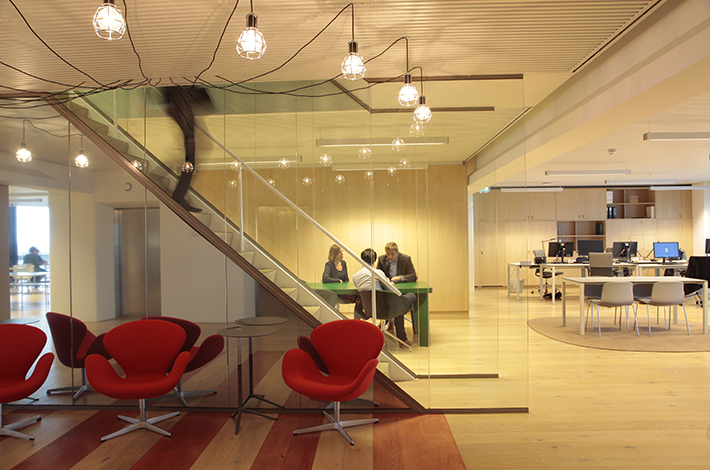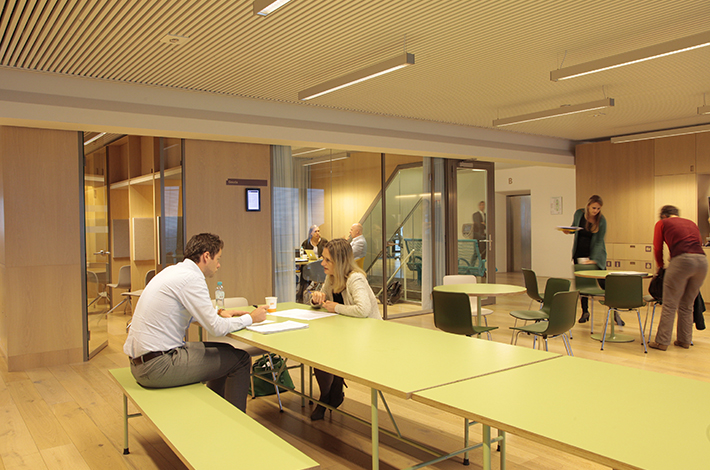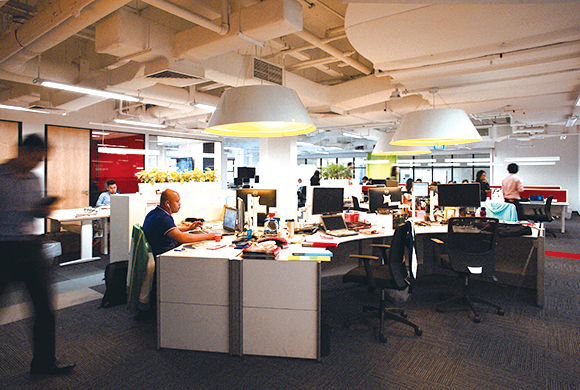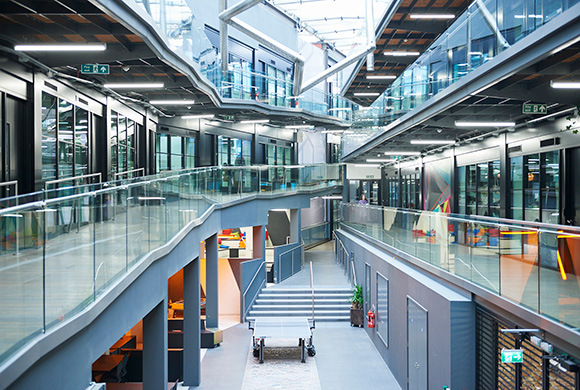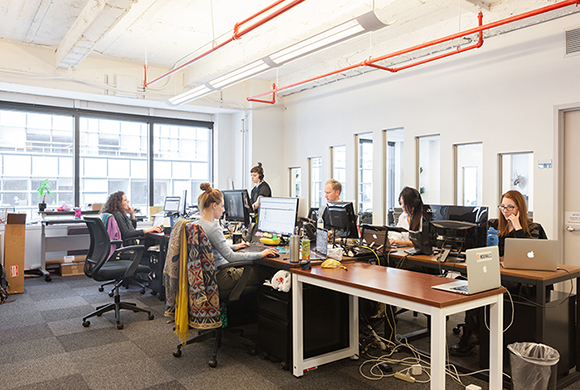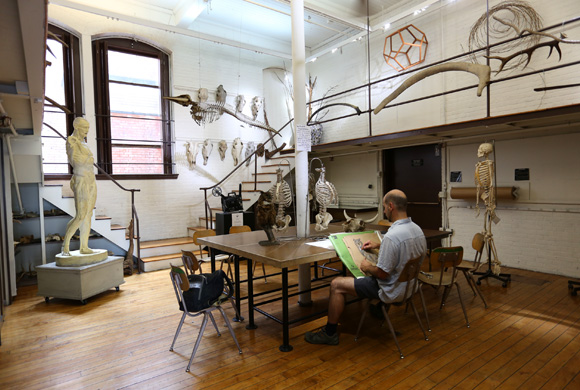Workplace
Mar. 2, 2015
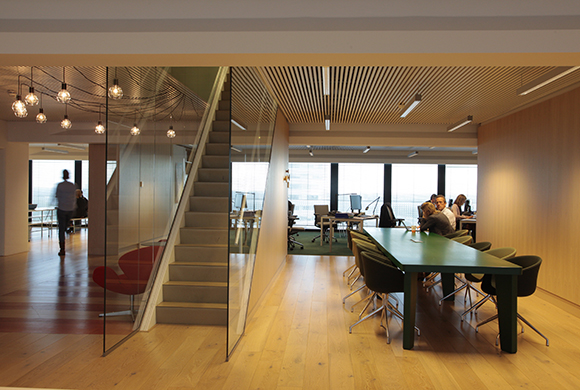
A place where employees freely come and go:
A flexible office, in a smokestack industry
A group company responsible for the stations on the Netherlands railway.
[NS Stations] Utrecht, the Netherlands
Nederlandse Spoorwegen (NS), the Dutch national railway, possesses some 2,800 kilometers of rail, and is the largest railway company in the Netherlands. One of NS’s subsidiary companies is NS Stations, which is primarily concerned with the development and operation of stations on the network. The company headquarters are right above Utrecht Station, the most widely used station in the country, and the one with the most train departures and arrivals.
The headquarters are the result of the remodeling of the old office building, which was in need of refurbishing. This work was completed two years ago, in the autumn of 2012. “Since we were going to do this, we decided to use a completely different design,” says Dick van Welzen, office renovation project manager. “We felt that we would use it for one year, without making any changes to the new concept, to give it a chance. But in fact the office feeling is very good—it’s bright, and even the coffee is good! Even the top executives like it, and I think we have met the expectations of the employees.”
Railway companies emerging from former national railway systems have by nature conservative cultures. Many might say that the image of these companies is rather old. But the new NS office is a reminder that this kind of thinking is also a stereotype.
Walter van Dyke, designer with NL Architects, which was in charge of the office design, talks about the project. “Our design team and the team at NS Stations had many discussions, so we knew that they wanted to make a major change in the corporate culture.”
The remodeling proceeded very carefully. “We pulled out employee needs through two different steps,” says Mr. van Welzen. “The first stage used the techniques of a traditional questionnaire.” Employees were asked what kind of environment they wanted in the new office, but not a lot of new ideas emerged. “People can’t make proposals about things they don’t know about,” Mr. van Welzen says. “That’s why we used a different kind of questionnaire for the second round.”
That second questionnaire asked those responding to talk about their preferences in office color, feeling and other factors in a unique way, using just ten words. The idea was to make it easy to write a response, and employees did in fact provide a range of responses. The NS Stations project team then took these responses to create what they called the 10 Definitions of the Wishes for the New Office. “We brought these 10 definitions to the architectural firm, and based our design requests on them,” Mr. van Welzen says. “This helped Walter to see the most attractive design.”
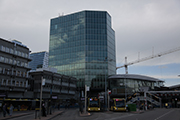 Located directly above and connected to Utrecht Station is the headquarters of NS Stations. Opposite is the headquarters of the Dutch railway.
Located directly above and connected to Utrecht Station is the headquarters of NS Stations. Opposite is the headquarters of the Dutch railway.
Established:1938
Employees:Approx. 5,000 (2014)
http://www.nsstations.nl
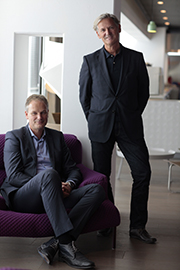 NS Stations’ Dick van Welzen (left) with designer Walter van Dyke.
NS Stations’ Dick van Welzen (left) with designer Walter van Dyke.
“The basic design concept began by eliminating all unneeded furniture but ensuring that there was plenty of storage space,” Mr. van Dyke says. “But all of it is mobile.” Only employees in departments handling confidential information are given fixed seating, while employees of all other departments put their personal belongings into lockers and work in free spaces. When work is finished, they tidy up before returning home.
When people need to come together in a group, they simply gather together the needed number of chairs. Because seats can’t be reserved, if four people want to gather and seats aren’t available, they ask other employees to change places with them. There are plenty of meeting rooms available, and they get plenty of use.
But because seats aren’t fixed, what do people do when work involves large volumes of materials? “With the office renovation, we also provided employees with the devices they requested—laptops, desktop computers, tablets, mobile phones, etc.,” says Mr. van Welzen. “Documents are steadily becoming digitalized, and moving to the cloud, so anyone can access all the documents they need anywhere. It’s impossible to completely eliminate paper, of course, but we’re down to 10 percent of the total amount of paper used just two years ago.” The company helps employees who are finding it hard to deal with the rapid changes with a practical training program in methods for the digitalization of paper documents and the use of tablets, while the IT staff also follows inexperienced employees. As a railway company, it has in fact long had training programs, something that seems to have paid off.
As the business has become more digital, the employees’ working style has also changed. It is now possible to work from home, and because the company now permits this it is common for people to work from home one or two times every two weeks. But while in general employees took to this well, “It took some time for the management team to get used to this,” Mr. van Welzen says. After all, without fixed seating bosses don’t know where their staff are located in the office, and working from home means people may not even be in the office.
After some time passed, however, management moved from seeing whether employees were coming to the office to making evaluations completely based on the outcome of the employees’ work. This represented a major change from the traditional management system. “For the top management at NS Stations, there is the strong feeling that not changing is not acceptable,” Mr. van Welzen says. “As a company, when the time comes that change is needed, it’s important that at least a part of the management is aware of this. The elimination of private offices was one part of this. We also created several training programs for managers, so that each person can renew themselves as well.”
It has been two years since the new office opened. The response from employees has been very positive. “We have created open spaces, and people now talk not only about business but private matters as well,” Mr. van Welzen says. There is a very pleasant feeling of easy communications between employees.
“People come to the office when they have meetings or other times when they need to gather, but it’s become common for people to work at home or other places outside the office,” says Mr. van Dyke. “In the future we will expand the number of meeting rooms, while I think the workspace will shrink.” Because the office’s convenient location right above Utrecht Station, it also has the position of the company’s conference or meeting center.
However you look at it, Mr. van Dyke says, “The cafeteria looks like a canteen, so we’d like more of a restaurant style. We actually have created a design concept which is just waiting for the company’s approval.” NS Stations, part of the NS Group responsible for the Netherland’s transportation infrastructure, will be a company that can change flexibly in the future.
Consultancy for work style:in-house
Office interior design:Nl architects
Architect:Of the original building Van schijndel, Van der Gaast
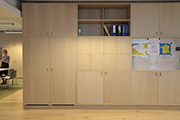
Storage space. The number of paper documents has decreased, so it’s doubtful that employees will complain that there isn’t enough storage space.
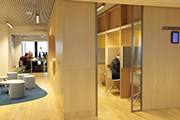
The concentration space has been provided for those who need to focus on work.
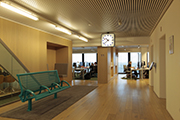
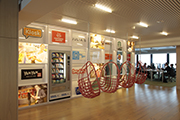
The design of the elevator hall is different on each floor. The station-related business floor is in a concourse style (upper photo), while the floor focused on retail business is decorated with partner company logos.


